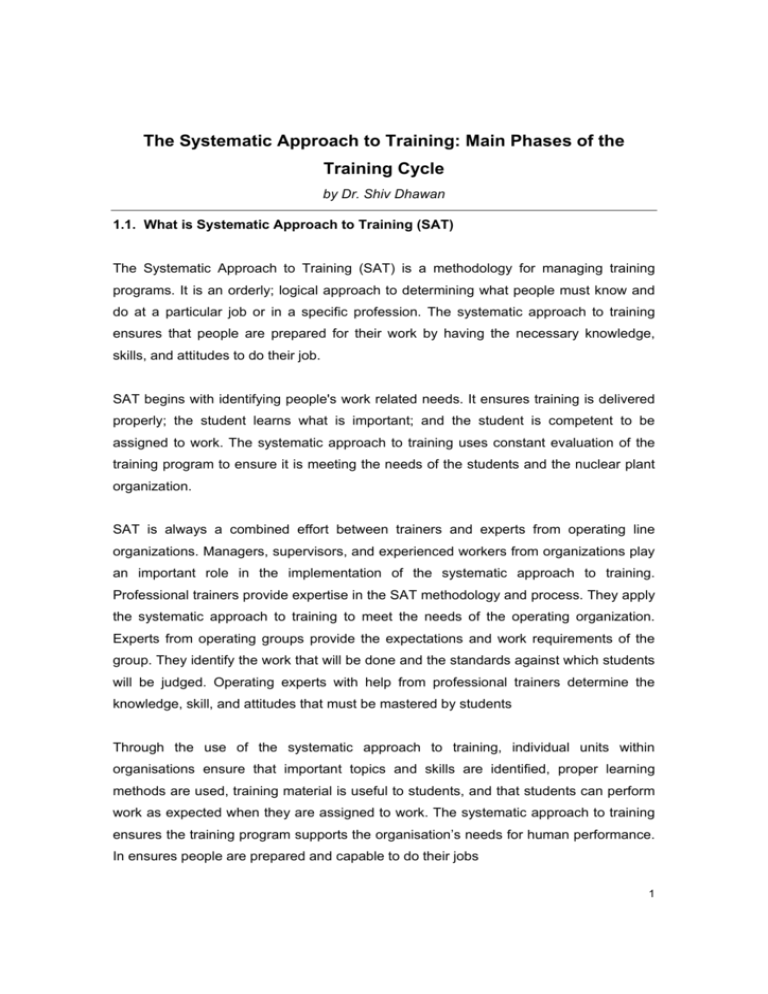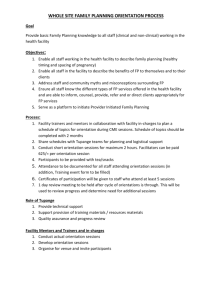The Systematic Approach to Training - Top
advertisement

The Systematic Approach to Training: Main Phases of the Training Cycle by Dr. Shiv Dhawan 1.1. What is Systematic Approach to Training (SAT) The Systematic Approach to Training (SAT) is a methodology for managing training programs. It is an orderly; logical approach to determining what people must know and do at a particular job or in a specific profession. The systematic approach to training ensures that people are prepared for their work by having the necessary knowledge, skills, and attitudes to do their job. SAT begins with identifying people's work related needs. It ensures training is delivered properly; the student learns what is important; and the student is competent to be assigned to work. The systematic approach to training uses constant evaluation of the training program to ensure it is meeting the needs of the students and the nuclear plant organization. SAT is always a combined effort between trainers and experts from operating line organizations. Managers, supervisors, and experienced workers from organizations play an important role in the implementation of the systematic approach to training. Professional trainers provide expertise in the SAT methodology and process. They apply the systematic approach to training to meet the needs of the operating organization. Experts from operating groups provide the expectations and work requirements of the group. They identify the work that will be done and the standards against which students will be judged. Operating experts with help from professional trainers determine the knowledge, skill, and attitudes that must be mastered by students Through the use of the systematic approach to training, individual units within organisations ensure that important topics and skills are identified, proper learning methods are used, training material is useful to students, and that students can perform work as expected when they are assigned to work. The systematic approach to training ensures the training program supports the organisation’s needs for human performance. In ensures people are prepared and capable to do their jobs 1 There are five main phases in the systematic approach to training. They are Analysis, Design, Development, Implementation, and Evaluation 1.2. Analysis The first phase in SAT is analysis. The first questions that must be asked are "Is there a need for training?" and "If something is wrong, is it caused by a performance problem that training will fix?" Managers sometimes will attempt to correct a human performance problem caused by an inadequate procedure or faulty equipment by training the people. Trainers sometimes attempt to use training to correct problems even though training will not solve the problem because they want to help. Make sure training is needed. Then analyze to determine what training should be done. In the analysis phase the duties of a job are identified and listed. The tasks that must be done to accomplish the duties are analyzed. Often we find tasks that are so large that we must break them into smaller parts that we call task elements. From the tasks and elements we determine the knowledge, skills, and attitudes needed to successfully perform the task. Tasks are reviewed and characterized by difficulty, importance, and frequency to help determine whether training is required prior to performing the task. These groupings also help us select tasks on which workers will receive continuing training throughout their careers. A more difficult task would have training associated with it. An easy task may not have formal training, but may only have a procedure for the worker to follow. Tasks that are important to safety or operation would have training. Routine tasks with no impact on safety or operation may not have training. Infrequently performed tasks usually have training completed just before they are to be performed. Infrequently performed emergency procedures usually have training performed often so operators are always ready to take emergency actions. The involvement of operating line managers is important to the analysis process. Trainers should not be expected to know everything about a job. They are not expected to set the performance standards for the operating group. This is the responsibility of the operating group. The operating group must provide the standards and their expectations for student performance to the trainers during the analysis phase. The trainer will use 2 these standards for successful performance of work to create the standards for passing the training course. During the analysis phase trainers will attempt to identify the knowledge and skills of future students. This will allow the course to be designed to meet their learning needs. If students were laborers with little education, a math course may be necessary to learn to read plant instruments. If students were engineers, the math course is probably not necessary. The outcome of the analysis phase is a task analysis that lists the tasks that are performed to accomplish the duties of a position and the knowledge, skills, and attitudes necessary to perform the tasks. These become the basis for the design of the training course and for writing the student learning objectives. 1.3. Design The design phase is really a decision making phase. In the design phase we complete three important activities: 1. We decide what the student will learn in the class and how that learning will transfer to the job. From this activity we write student-learning objectives. 2. We decide what will be taught and the instructional methods to be used to teach. 3. We decide how the student will demonstrate competency to do the required work and we develop an examination plan to test the student's competency. Learning objectives are often broken into two types. Terminal objectives explain what the student must be able to do after training on the job. Specific learning objectives (sometimes called enabling objectives) tell what knowledge, skills, and attitudes must be displayed during class. They are written in words the student can understand. There should be no surprises for students, instructors, or supervisors. Students are given the learning objectives at the beginning of class so they know exactly what we expect them to learn. The learning objectives are based upon the results of the analysis phase. The student examinations are based upon the learning objectives. 3 The design phase also determines what will be taught and how it will be taught. In this phase we select the instructional technology and the media to be used. The instructional technology usually includes some combination of the following: hands on practice, lecture, overhead transparencies, video tape, training equipment, computer training, pictures, models, student reading, self study, or on the job training. It is important to decide how the student will practice the skill to be learned. During the design phase the trainer researches existing training material to determine if material already exists to teach these learning objectives. If material is not available, the trainer considers whether to develop new material or to purchase material from an outside supplier. Using the learning objectives as the standard, the trainer develops an examination plan to determine if the student is competent concerning the course material. This plan states the learning objectives to be tested and the number of questions relating to each learning objective. We determine the type of question and difficulty level of the questions. An examination table of specifications is written to guide the actual writing of questions in the development phase. Managers from the operating group normally approve the design before the development phase begins. This ensures that the nuclear plant's needs are being met by the course. 1.4. Development In the development phase the training design is made into training material. Training materials for instructor and students are written or purchased. These materials could include lesson plans, student handouts, videotapes, training aids, or other material. Examination questions are written as required in the examination table of specifications from the design phase. Questions are assembled into student exams as needed. 1.5. Implementation In the implementation phase the instructor teaches and the student learns. Although this is the phase that most people think of as "training" it is the easiest phase to perform. The 4 material written during the development phase is used to implement the decisions that we made in the design phase. We also apply the information learned about the job in the analysis phase during implementation. At the completion of the course the students prove their competency by passing the course examination. 1.6. Evaluation Evaluation is usually listed last. However, evaluation is done throughout the SAT process. Evaluation is asking, "How are we doing?" During the other three phases trainers do an evaluation to ensure the process is working correctly and to identify improvements immediately. After the training is completed trainers evaluate the effectiveness of the training. They determine if the student is performing on the job as expected. They determine if the training course was useful to the organisation’s performance. Trainers identify what else is needed to improve performance and determine if the course could have been done better. Identifying improvements for the course and improvements for the entire training process is an important part of the evaluation phase of SAT. The best evaluation of training effectiveness is done on the job. We ask students and their supervisors if they are properly prepared to do their job. We also use plant performance monitoring programs to evaluate the effectiveness of training and determine areas for improvement. Operating line managers must be involved in the evaluation of training for it to be most effective. _______________________________ Dr. Shiv Dhawan is currently working with the Global Government Consulting Practice within Tata Consultancy Services Ltd. He has more than a decade and half of hands-on experience in designing and delivery of training courseware in behavioural sciences. This paper is an attempt to map the training process. 5




